

Max Davies
2026 Toyota HiAce review
7 Hours Ago
The Folgore is a remarkable first-time effort at a high-end electric GT that also offers hypercar performance without compromising comfort.
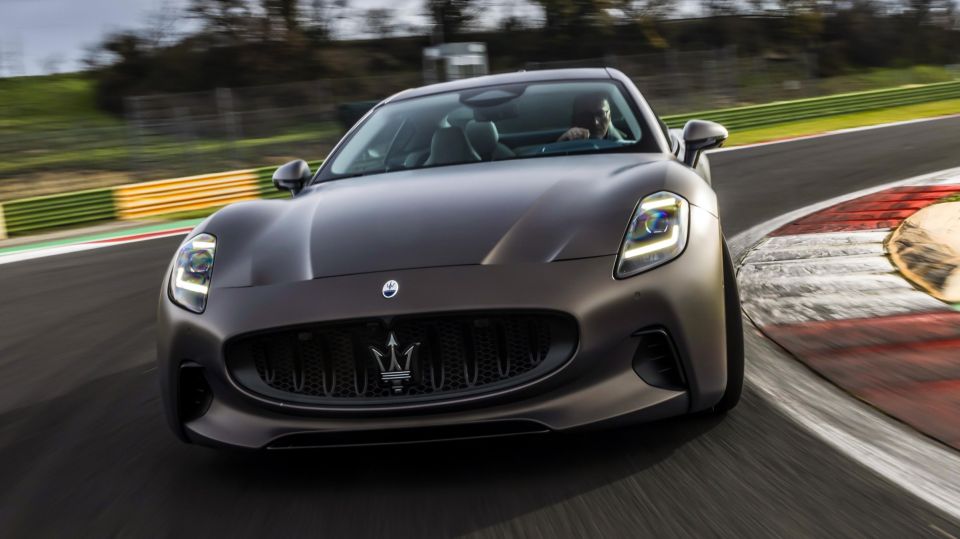
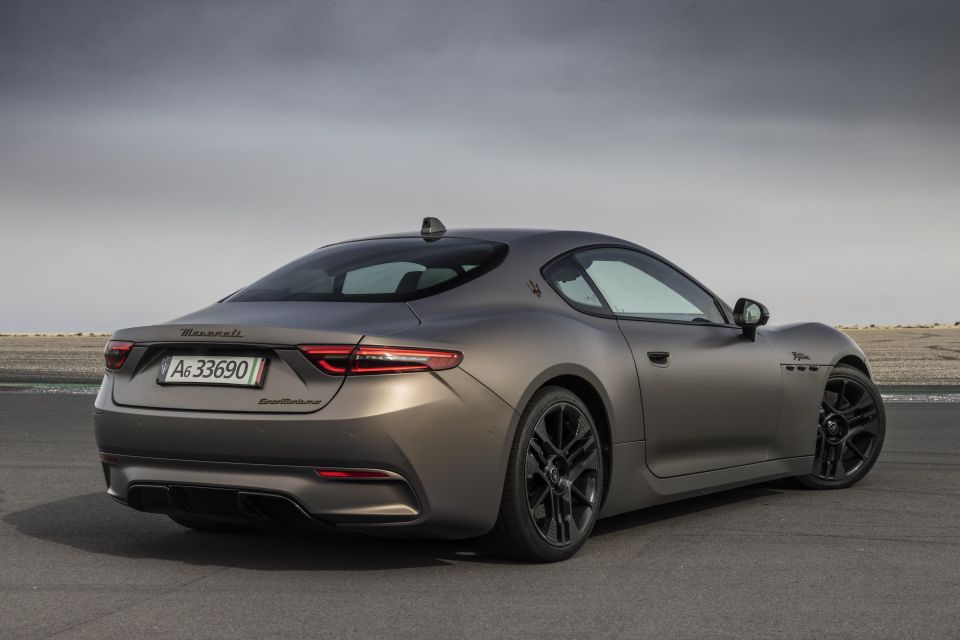

Senior Road Tester

Senior Road Tester


Senior Road Tester

Senior Road Tester
Where expert car reviews meet expert car buying – CarExpert gives you trusted advice, personalised service and real savings on your next new car.
If you’re looking to park the fastest Maserati GranTurismo in your garage, it won’t be the high-powered Trofeo packing the sensational twin-turbo Nettuno V6 out of the MC20 super sports car.

Instead, you’ll be wanting Maserati’s first ever fully-electric vehicle in the marque’s 109-year history – the GranTurismo Folgore. Not just because its electric or eco-friendly, mind, but because it can unleash more firepower than the entire Italian Navy.
Armed with a total of three 300kW permanent magnet electric motors; one up front and two at the rear, the GranTurismo Folgore generates system outputs of 610kW of power (on boost) and a mind-blowing 1350Nm of turbo-crushing torque.
Those motors reach higher levels of power density (9.2kW/kg), thanks to the use of silicon carbide (SiC) inverters derived from Formula E racing.
The 92.5kWh battery pack itself weighs slightly less than 600kg, and has a discharge capacity of 610kW, which it continuously transmits to the wheels.
Like other high-performance EVs with multiple electric motors, the Folgore’s power unit is also built around state-of-the-art 800-volt technology in order to unleash such considerable power as well as undertake rapid charge times.
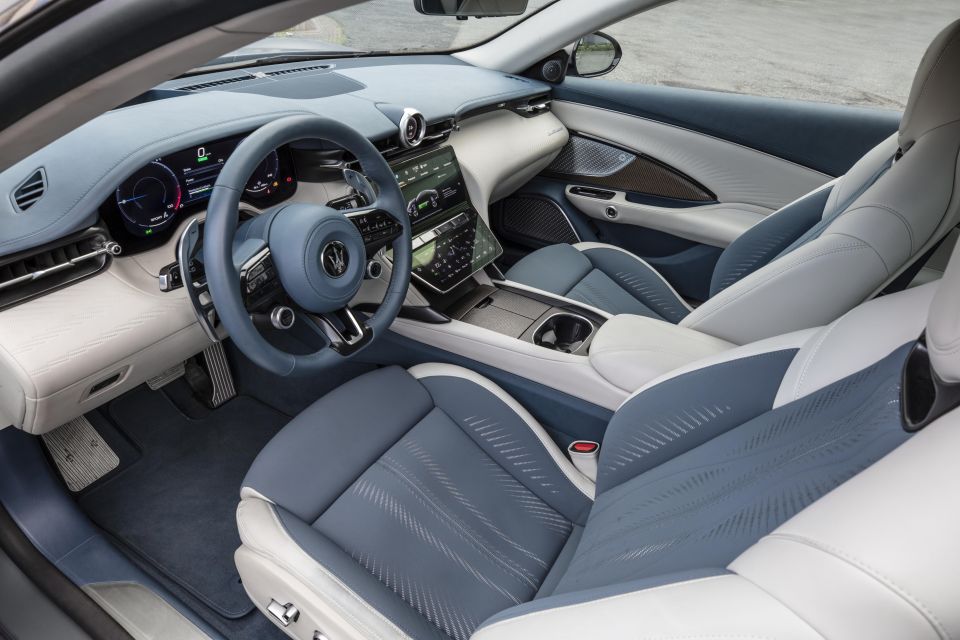
But it’s the shape and design of the battery pack that is unique to the Folgore and the principle reason for its claim as the lowest electric car on the market.
To put that into context the Porsche Taycan stands 1380mm tall, while the four-door Audi e-Tron GT measures 1411mm and Tesla’s Model S rises to 1045mm at its highest point.
Maserati has dubbed it the T-Bone, which avoids the usual practice of placing the battery modules under the seats by moving them around the central tunnel which has enabled a very low H-point in the car and an overall height of just 1353mm – identical to the Modena and Trofeo petrol versions of the new GranTurismo.
The two rear motors are completely independent of each other as there’s no traditional transmission to connect the wheels which makes it possible to direct torque to each side, independent of each other. In the Folgore, the torque vectoring system is more variable than the system on the ICE versions, though the entire GranTurismo range is all-wheel drive.
Unlike other performance EVs on the market, the GranTurismo Folgore can direct 100 per cent of power to the rear axle alone, even when driven in rear-wheel drive configuration only, or up to 294kW to a single rear wheel.
The Folgore also offers close-to-one-pedal driving thanks to regen levels of up to 0.65g initiated through the paddles, but it’s not as pronounced or as effective as you get in the Taycan or even BMW’s i4 M50, so more reliance on the brakes is required.

Maserati also says handling and agility are two of Folgore’s key assets, and point to its smaller inertia tensor made possible by positioning most of the car’s mass close to the roll axis. It means the axial geometry in the battery allows for quicker changes of direction than in cars with a platform battery arrangement.
Better still, the second-generation Maserati GranTurismo is also blessed with a 50:50 weight distribution for the Folgore, while the ICE versions are 52:48 by comparison.
It might be the same lightweight GranTurismo body as its petrol-powered siblings, but up close and in the metal, dressed in its Rame Folgore matte sheen launch colour complete with copper-coloured Trident and badging – it’s quite spectacular.
And while it might be all-electric and the first such vehicle ever produced by the storied Italian marque, the Folgore is a car that maintains its instantly recognisable GranTurismo proportions, including long bonnet and steeply tapered roofline. There’s now more emphasis on the curve of the C-pillar which features a more elegant version of the latest-look Trident logo.
The GranTurismo is built on the Maserati’s latest architecture which takes advantage of lightweight materials such as aluminium (65 per cent), magnesium and high-strength steel for what is a claimed best-in-class weight advantage across the range, including the Folgore EV.
It’s also no surprise the new GranTurismo looks more chiselled, thanks to an entirely new front end that sees the bonnet meld into the front fenders that gives the appearance of a single clamshell-style panel that Maserati calls the ‘cofango’. It’s a portmanteau made up of both cofango (bonnet) and parafango (fender), and refers to one component made up of two parts.

Maserati claims the surface area of the cofango is a market-leading 3.0mthat uses industrial moulds to create GranTurismo’s more curvaceous panels.
Like all versions of GranTurismo, the Folgore borrows design cues from the MC20 supercar, including vertical headlight assemblies and 3D Trident logo on the grille. The grille itself is unique to the EV with gloss-black inserts on a partly anodised silk black base.
There’s more gloss black for the splitters, door handles, daylight opening and rear handle, while the Trident logo and script, including ‘Maserati’, ‘Folgore’ and ‘GranTurismo’ are in dark copper.
It’s the combination of Folgore-specific splitters, diamond-cut gloss-black wheels and front diffusers that contributes to its 7.0 per cent improved drag coefficient (0.26) over petrol versions of GranTurismo (0.28). And, to reduce wind noise inside the wheel arch, there’s an air inlet placed between the bumper and wheel arch.
For some perspective, the MC20 has a Cof 0.38, which isn’t all that good, likely the result of extra cooling intakes designed to Jettison heat in the engine bay.
The rear LED tail lights are also new, although it’s a mix of Maserati’s classic boomerang design and a harpoon symbol, which gives the effect of a lower profile look overall.
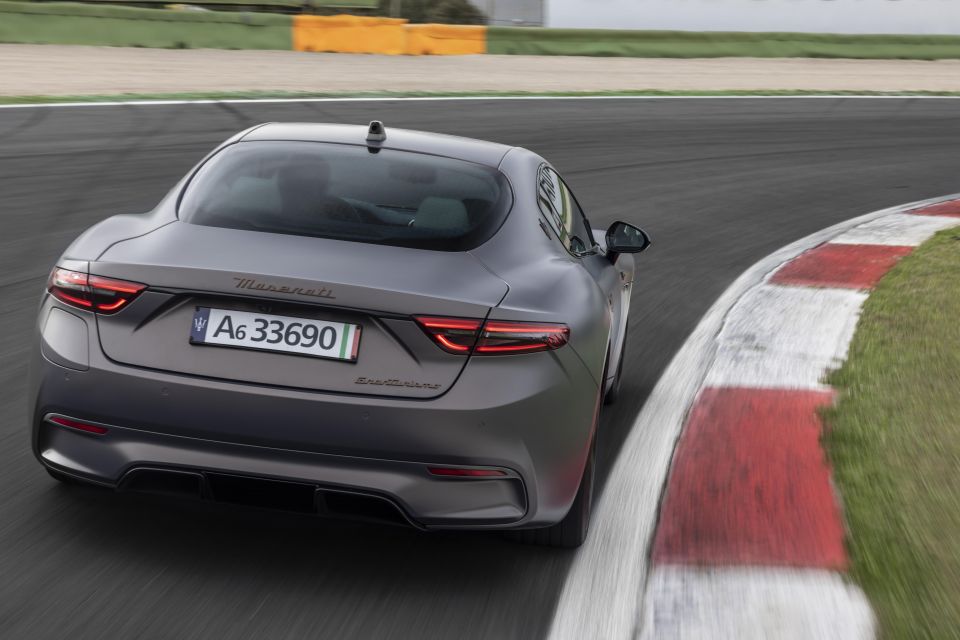
Despite the all-electric powertrain, Maserati has created an “all-round sound experience” by engineers at the Maserati innovation Lab, who have used the 1195W, 19-speaker Sonus Faber 3D audio system to achieve a ‘signature’ Maserati sound experience specifically for Folgore.
In reality, it’s more like an extra-loud hum, as if you were standing by an electric substation, so it’s also strangely ominous if you happen to be standing beside it. In fairness to Maserati, the sound engineers say they are still working on Folgore’s EV sound, but at the moment it’s not quite emotive enough for my liking.
The Folgore also gets the same staggered wheel and tyre set-up as the petrol versions (front – 265/35 ZR20, rear – 295/30 ZR21), though slightly lower-profile rubber up front. The wheel itself is clearly an aero-driven design for reduced turbulence at speed through better airflow.
Braking hardware remains the same across the entire GranTurismo range, with Brembo six-piston 380mm brakes up front, and four-piston 350mm stoppers at the rear. That’s despite the Folgore tipping the scales at 2260kg, 456kg more than petrol versions.
Maserati told us the Folgore doesn’t need any larger stoppers due to the assistance provided by the regen – but for such a heavy vehicle capable of such mind-blowing acceleration and speed, I might be tempted to option a set of carbon ceramics, if they were available.
With cars not scheduled to land in Australia before end of 2023-24, Maserati won’t set pricing and specifications until closer to the vehicles arriving.
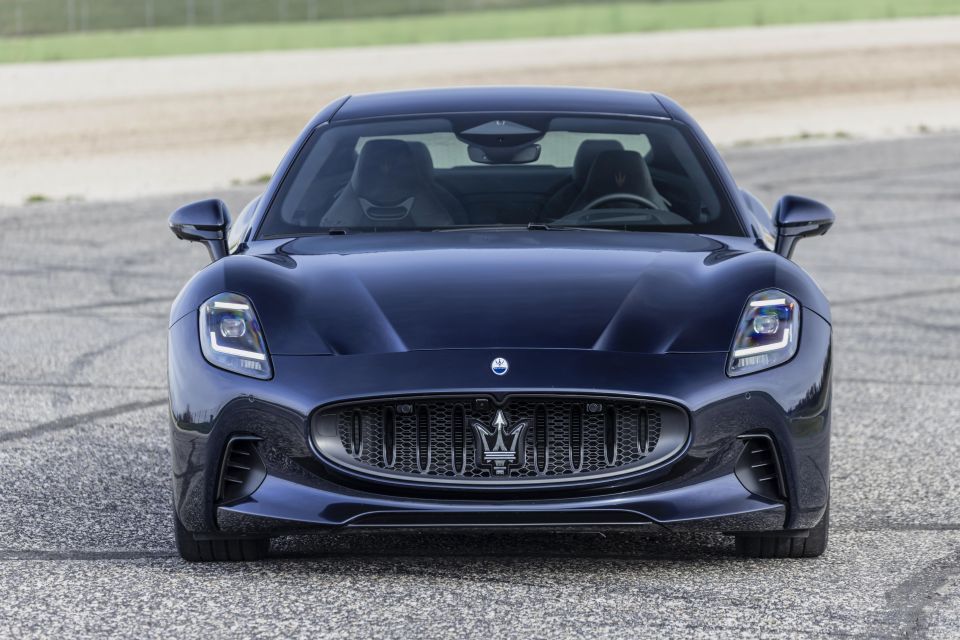
Nevertheless, expect the Folgore to sit above the Trofeo as the range-topper.
Luxury two-door EV rivals are almost non-existent, but likely competition would include the Porsche Taycan Turbo S ($351,000), BMW i7 xDrive60 ($297,900), Audi RS e-tron GT ($248,200) and not much else.
Moving into pure GT competitors, you’d likely include the BMW M8 Competition Coupe ($362,900), Aston Martin DB11 AMR ($437,400), Bentley Continental GT Speed ($543,400) and Ferrari Roma ($409,888).
Buy your new car without the stress. It's fast, simple and completely free.

Great service from Travis and team, second time I have used this business would not hesitate to recommend them to anyone
Craig C.
Purchased a Ford Ranger in Sunshine Coast, QLD
CarExpert helped Craig save thousands on his Ford Ranger, now let us save you on your next new car.
Find a dealApart from slightly different graphics on the digital instrument display in keeping with the electric drivetrain, as well as a few unique materials exclusive to the Folgore, the cabin is pretty much the same spacious space with an array of high-quality touchscreens and all the latest technology you could ever want in your electric Maserati GranTurismo.
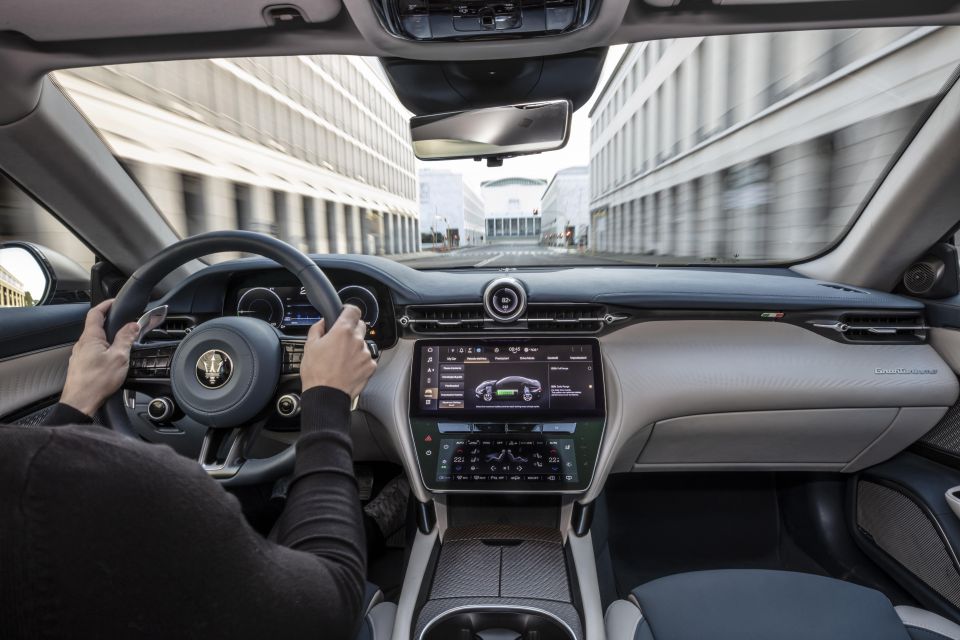
Two interior themes are available for the Folgore: a light Ice/Denim version, or black upholstery and contrast stitching in copper. The 18-way seats are built on a lightweight frame with integrated headrests and heating and cooling.
There’s also a sustainable fabric option called Econyl, made from recycled nets from the world’s oceans that resembles bodysuit material, combined with laser processing.
It looks sharp but more importantly, it feels like a very fine wetsuit material, only the very expensive types you get from custom Japanese fabricators.
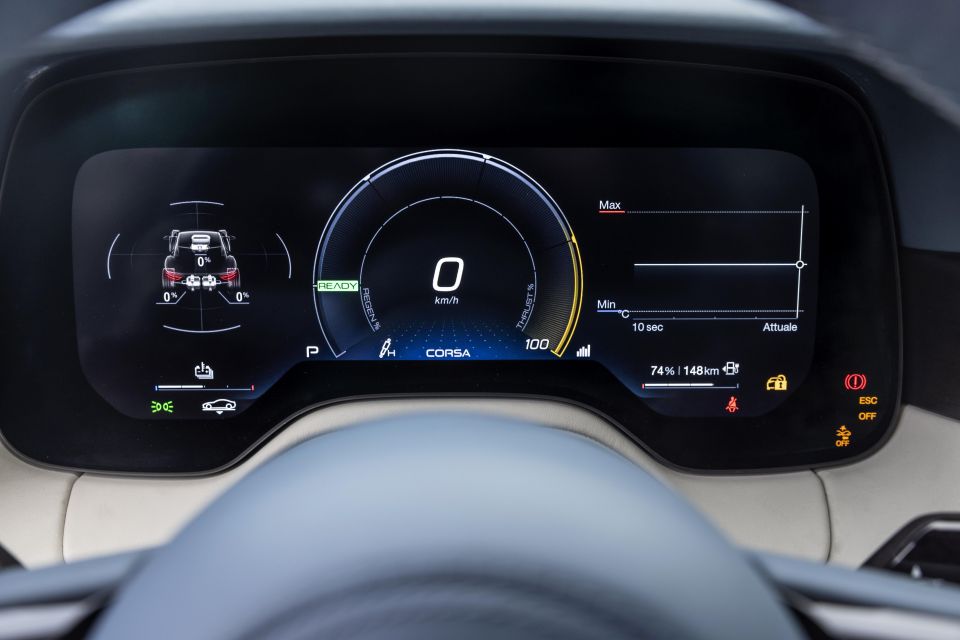
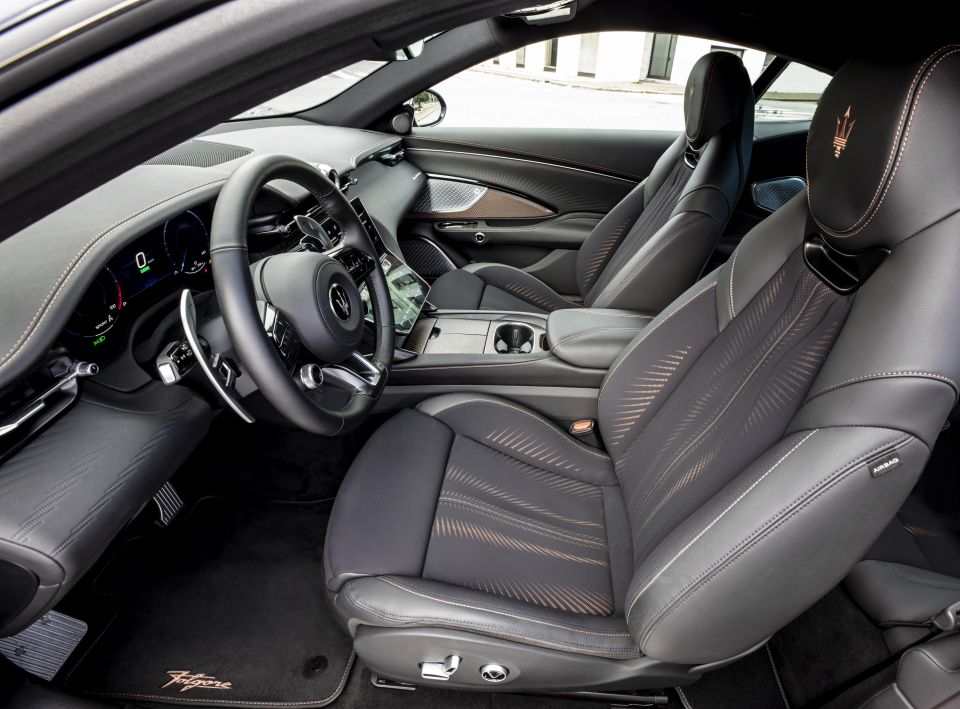
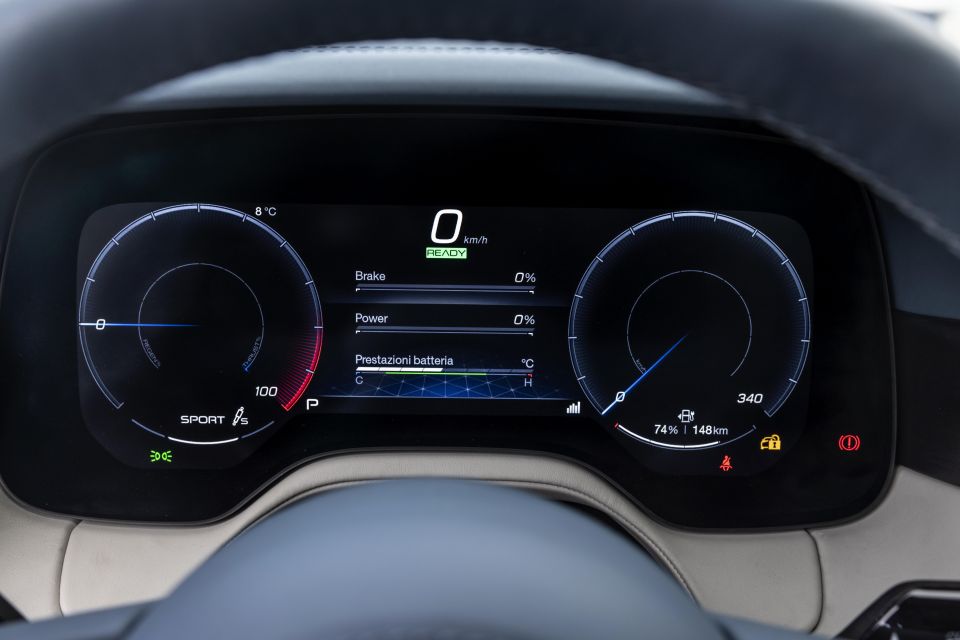
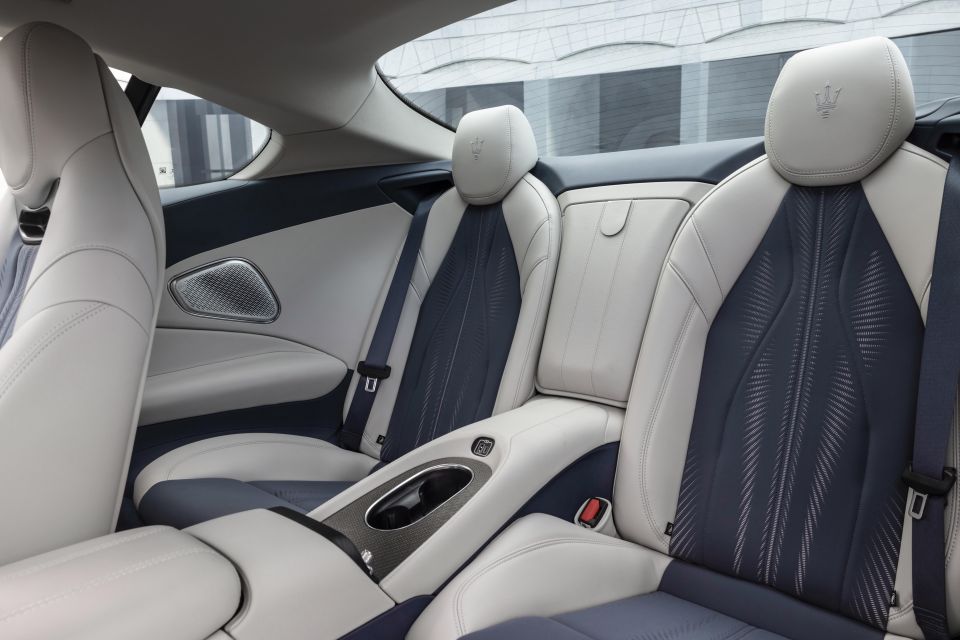
Also exclusive to the Folgore is an innovative lasered surface treatment for the dashboard and inside the doors.
Just as rear legroom has grown by 46mm, boot capacity has increased by 20 per cent to 310 litres in the petrol versions, Folgore gets slightly less at 270L due to the entire EV packaging.
And, for those who might doubt the factory specs concerning rear-seat comfort – my 58km stint was in the back of the Folgore and I can confidently say it was truly comfortable – at least for my 175cm frame. Plenty of head, knee and elbow room combined with a slightly elevated seat height for a properly spacious feeling back there.
The Maserati GranTurismo Folgore swaps the characterful twin-turbo Nettuno V6 for three electric motors, two in the rear and one up front for combined maximum outputs of a staggering 610kW (on overboost) and 1350Nm of torque.
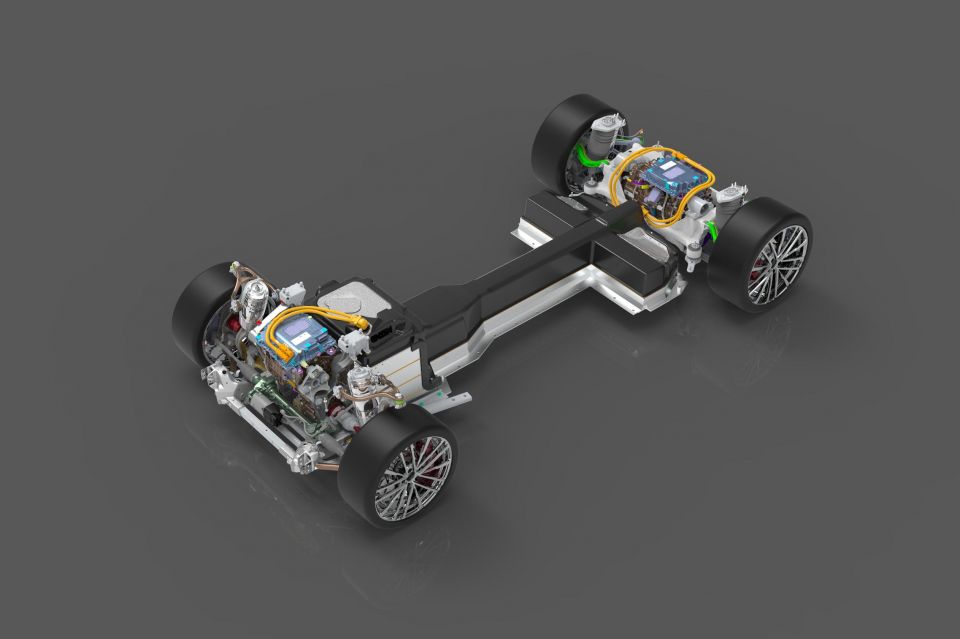
The motors reach levels of power density of 9.2kW/kg and are driven by silicon carbide (SIC) inverters taken from Formula E racing.
It’s enough to catapult the Folgore from standstill to 100km/h in a toupee-removing 2.7 seconds and zero to 200km/h in a dragstrip-melting 8.8 seconds – at least that’s the claim. And, after 200km of seat time behind the wheel – there’s absolutely no argument from this reviewer. Top speed is 325km/h, which is staggering in itself.
Folgore uses 800-volt technology in order to be able to discharge such high levels of power as well as to undertake rapid charge times for its 92.5kWh battery. With a 270kW fast charge, Folgore owners will be able to increase the car’s range by 100km in five minutes.
DC charging also offers charging from 20 – 80 per cent in 18 minutes, while at home using up to 22kW from the freely-supplied wall charger – you would get 100km of range in one hour. Maximum claimed WLTP range is 450 kilometres.
Just the thought of driving the Folgore was a little bit intimidating, and that’s after some good seat time behind the wheel of the very rapid GranTurismo Trofeo.
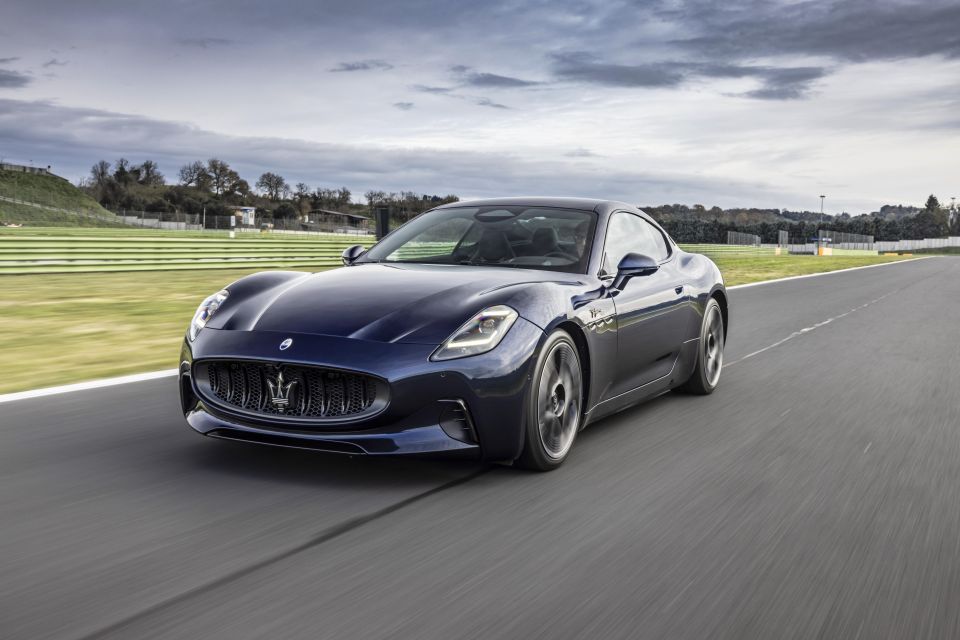
Those outputs and performance claims for Folgore are big numbers and can mess with your head a bit. Especially driving it on less-grippy winter tyres in cold temperatures.
Nevertheless, the battery-electric Folgore gives drivers four individual driving modes: Max Range, GT, Sport and Corsa, which can be accessed via the steering wheel selector.
In Max Range it’s all about saving energy, recommended when battery levels drop below 16 per cent with no charging facility immediately available. This mode limits the top speed to 130km/h, dials back throttle response and reduces the power of the climate control.
Maserati claims Folgore’s maximum range is 450km using the WLTP test cycle, while a full tank in the petrol versions is good for 650km.
Like its Modena and Trofeo stablemates, GT is Folgore’s default drive mode for what Maserati claims is a genuine all-round driving experience, though peak power is curbed at 80 per cent, with some in-car sound noticeable.

Sport amps everything up driving on public roads with 100 per cent of power available and the adaptive suspension stiffer for increased handling loads. Torque vectoring also reduces any understeer in both regen and coasting situations, and there’s more of that EV sound. Drivers can also enable launch control in this mode as well as in the track mode.
Corsa(Race) mode unleashes maximum available power from Folgore’s 800-volt power unit as well as minimising stability control systems. This mode also ramps up all the major controls, including throttle response and torque delivery from all three motors. Additionally, the suspension stiffens and ride height is lowered.
Corsa also lets drivers make further adjustments through the drive mode controls on the infotainment screen for situations from wet-surface performance to maximum drift angles.
Moreover, powertrain management on the run is made possible using Max Boost and Endurance, which allows for all-out performance on track over a prolonged period by managing the vehicle’s temperature.
First off, seat time in GranTurismo Folgore was limited due to there being only two pre-production versions at the launch event.
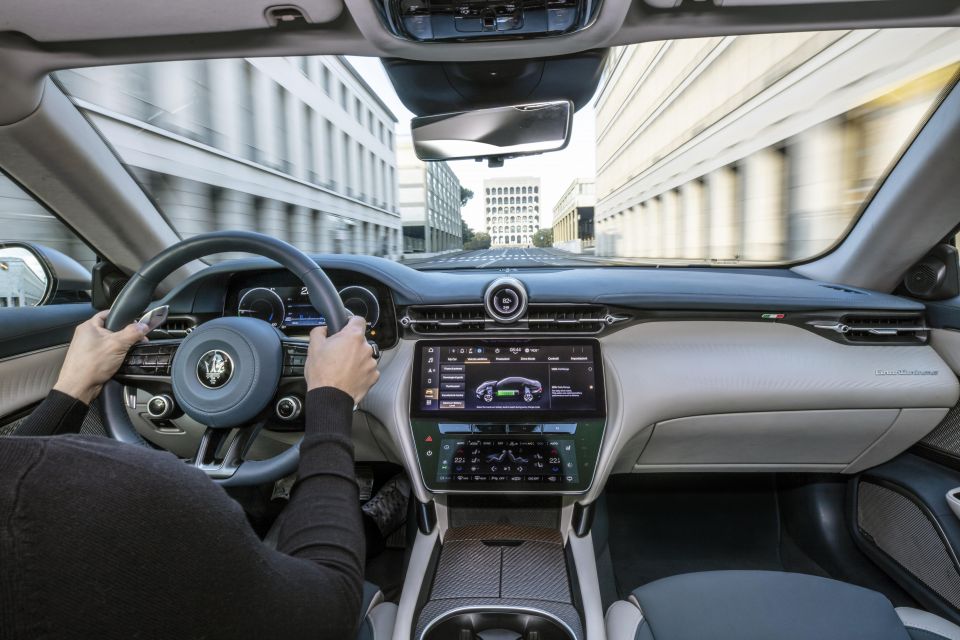
Nevertheless, orientation only takes a minute or two before we were free to unleash an obscene amount of power and torque on the Italian countryside around Nepi.
There’s nothing to it. You just push the same Start/Stop button on the steering wheel as you would in the Modena or Trofeo, hit Drive, and away you go – in utter silence but for that ominous ‘i-Robot’ hum I mentioned earlier.
The steering weight is perfect – meaty but also perfect on-centre. It’s quick too, quick enough to make some rapid split-second manoeuvres to avoid a tractor entering the roadway, seemingly without warning.
It’s mid-afternoon on a Monday and there’s a need to pass two or three cars safely in a single overtaking move. No problem, you just hit Sport, give it a boot full – and hang on tight. Holy moly, never has a multi-car pass been so easy or so safe.
Not only is the acceleration mind-bending (I mean that literally) the power delivery is completely linear and simply doesn’t let up – it’s just on another level entirely. It feels more linear than a Taycan, but equally devastating for those not used to such blinding pace out of the blocks.
I’m not game enough to dial up Corsa mode or use Max Boost, because we’re on Winter tyres on relatively cool road surfaces. Even so, I’m truly surprised at the available grip in the twisties at a fairly rapid clip.
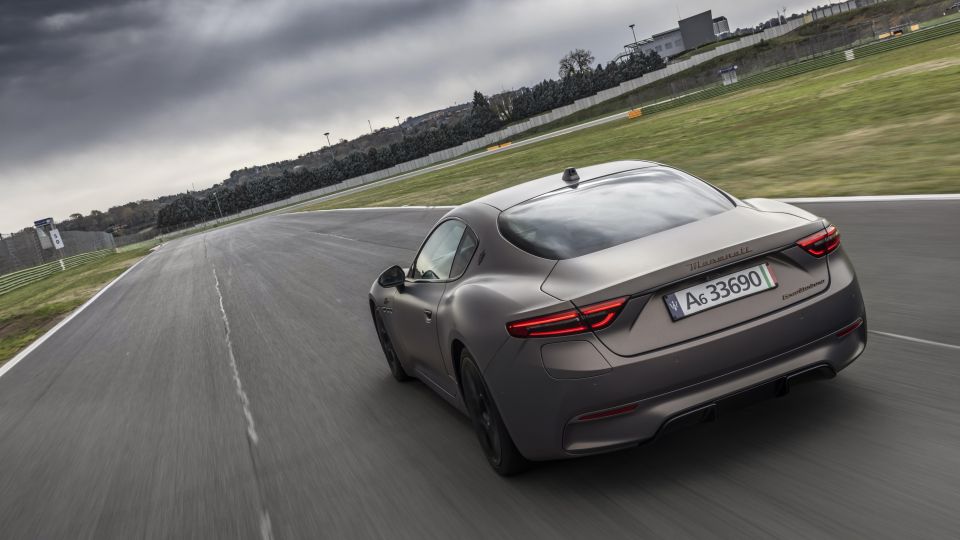
Where expert car reviews meet expert car buying – CarExpert gives you trusted advice, personalised service and real savings on your next new car.
What excites me most about the Folgore is despite it tipping the scales at more than 460kg heavier than the petrol versions, it’s still giving good feedback through all the major controls as well as offering excellent chassis balance.
It laps up quick directional changes and handles crappy roads and bumps as good as anything EV I’ve driven to date. Mid-corner bumps don’t unsettle it either – you don’t give a second thought before you’re going full-tilt ballistic again. And, that’s me after a sting riding in the back seat.
If I thought there was anything that might need some further attention it would be the brakes, but I’m also reticent about that due to the winter tyres we were on over here. The regen just isn’t quite as strong as that in the Taycan or the BMW i4 M50, iX M60 and i7 and those cars also have super-strong brakes to boot.
If Maserati ever offer carbon-ceramic brakes (at least on the Folgore), I’d be ticking that box before any other option. A local drive on summer tyres will likely reveal much more about Folgore and the petrol versions.
While local specifications will be published closer to the car’s arrival in 2024, here’s what we do know.
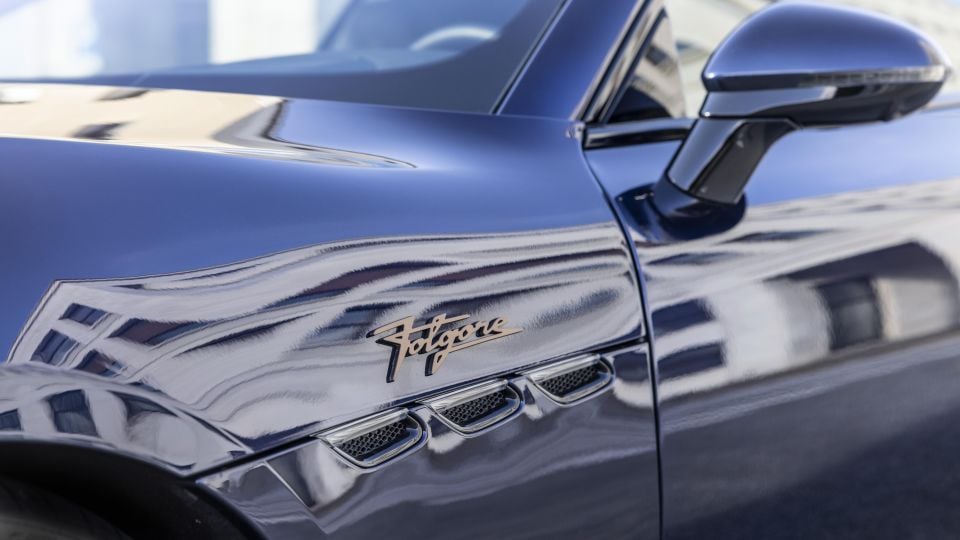
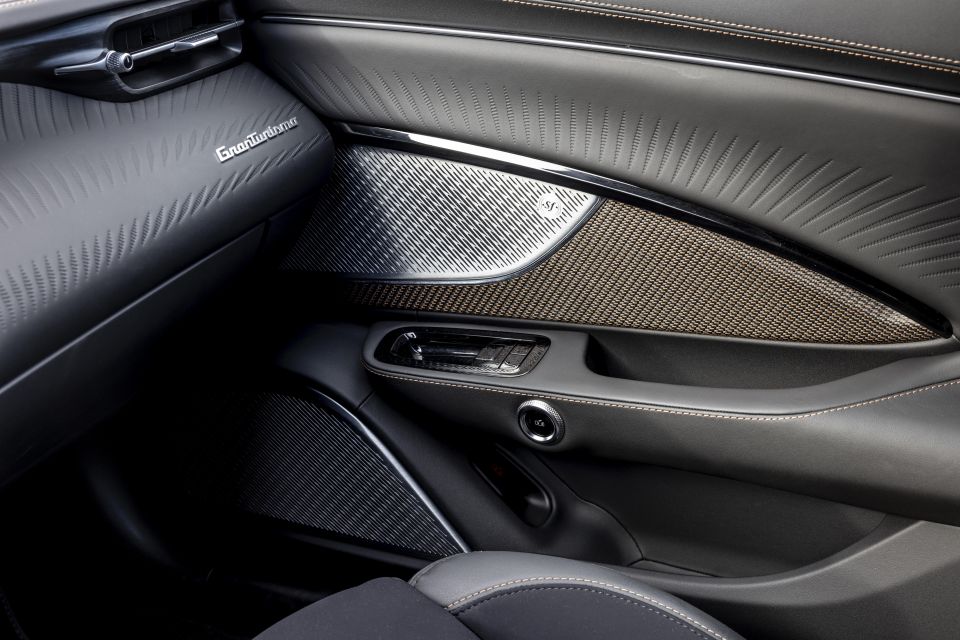
All variants of the GranTurismo range, including the Folgore, use double-wishbone front suspension with air springs with electronic adjustable dampers.
All three variants have multi-link rear suspension, with single-chamber air springs and electronic adjustable dampers. The Modena has a mechanical self-locking rear diff, while the Trofeo and Folgore use an electronic self-locking unit.
Each use 380 x 34mm front ventilated discs with Brembo six-piston fixed calipers, and 350 x 28mm rear ventilated discs with Brembo four-piston fixed calipers.
The brake calipers also come in a range of seven colours, including matte Nero, Nero, Rosso, Giallo, Blu, Matte Rosso and Matte Dark Rame (exclusive to Folgore).
The staggered wheel configuration comprises 21-inch rims with 295/30 tyres at the rear, and 20-inch wheels with 265/30 or 265/35 rubber at the front. The Folgore features unique Aero wheels designed for optimum aerodynamics.
Folgore also sits lower than any other battery-electric car on the market, but at 2260kg, the Folgore EV weighs a whopping 465kg more than the Modena and Trofeo (1795kg) versions.
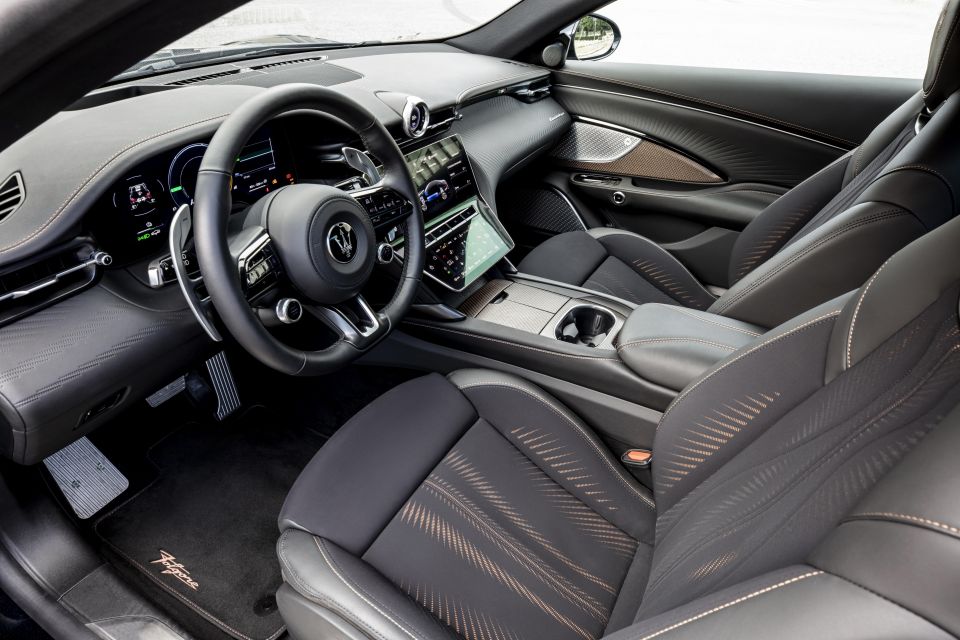
Inside, the GranTurismo, regardless of variant, features a 12.3-inch touchscreen infotainment system, a 12.2-inch digital driver’s display with four different layouts, and an 8.8-inch lower display for the climate control.
There’s also a projected head-up display, along with a digital rear-view mirror (in addition to the standard view), borrowed from the MC20 supercar.
The infotainment system runs on the Android Automotive operating system and includes wireless Apple CarPlay and Android Auto, and gives owners the option to create up to five user profiles. There’s also standard gesture control.
With Maserati Connect, GranTurismo owners also get Amazon Alexa Home-to-Vehicle control, on-the-road connectivity, Maserati Guard stolen vehicle tracking, and over-the-air software updates. A 14-speaker 860W Sonus Faber sound system is standard, with a 19-speaker sound system optional.
As with the Grecale, the GranTurismo gets a digital version of the Maserati’s trademark dash-mounted clock that’s not only multi-functional, but also responds to the voice command “Hey Maserati” to do things like change the cabin temperature. There are three available skins to choose from.

There’s no gear lever in the GranTurismo, freeing up space on the centre console.
There’s a new-style steering wheel also borrowed from the MC20 and Grecale models, though, slightly different and a unique Denim colour, exclusive to the Folgore and wonderfully tactile.
Prominent aluminium paddle shifters sit behind the wheel, even on the electric Folgore where they’re instead used to adjust the level of regenerative braking.
Instead of various leather options for upholstery, the Folgore features extensive use of sustainable materials, including Econyl fabric – a nylon produced from recycled fishing nets – on the seats, roof and pillars.
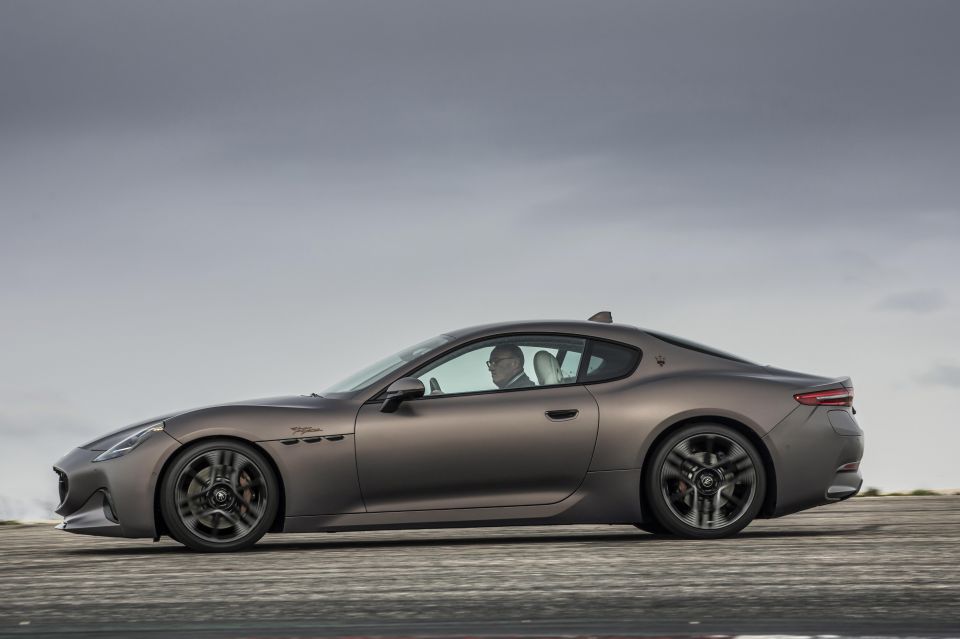
The 2023 Maserati GranTurismo has not been crash tested by either ANCAP or Euro NCAP and therefore has no safety rating applied to it.
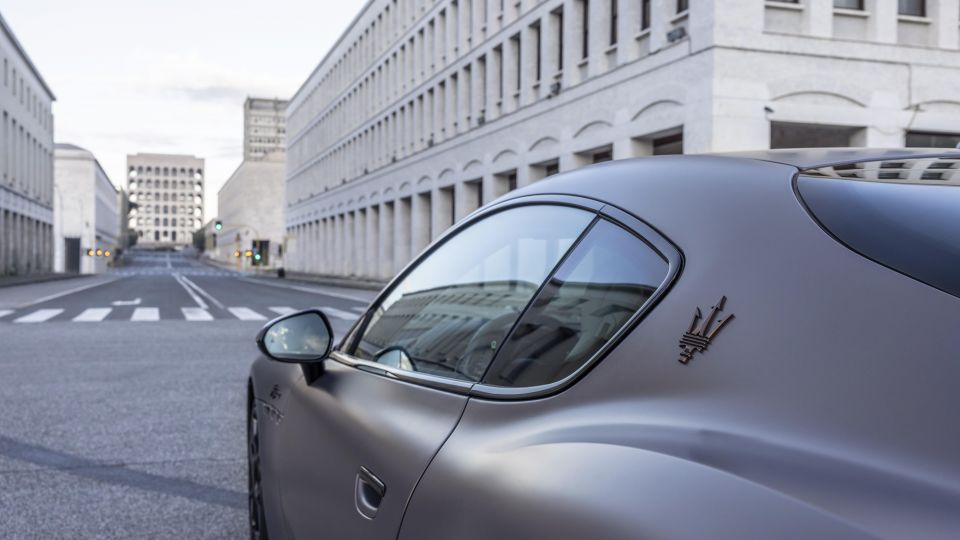
While we still don’t have pricing and specifications for the 2023 Maserati GranTurismo including an inventory of safety features, main safety features new to the model range include the following:
Maserati Australia will offer GranTurismo buyers a three-year, unlimited-kilometre warranty, along with three years free scheduled servicing and roadside assist.

It’s still unclear as to whether GranTurismo Folgore customers in Australia will receive a wall box solution that would need to be installed at home or their preferred charging location.
By any standards the Maserati GranTurismo Folgore is a remarkable first-time effort at a high-end luxury GT car that also offers hyper-car performance without compromising quality or comfort.
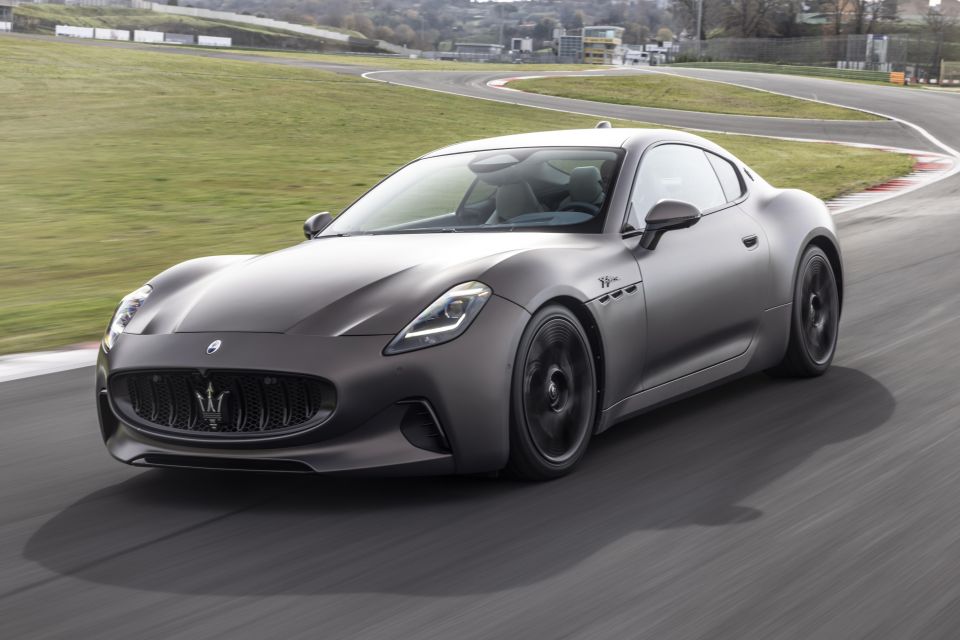
It doesn’t take long behind the wheel to realise there’s an awful lot of engineering know-how and passion gone into the new GranTurismo – especially the Folgore.
It feels like no expense has been spared here. Whatever it takes to get it right – straight out of the box.
And then there’s the design. Careful not to offend loyal GranTurismo owners but somehow better looking than its predecessor from any angle.
Technology was a sore point in the previous-generation car – but now it’s as good as anything on the market and perhaps even more robust.
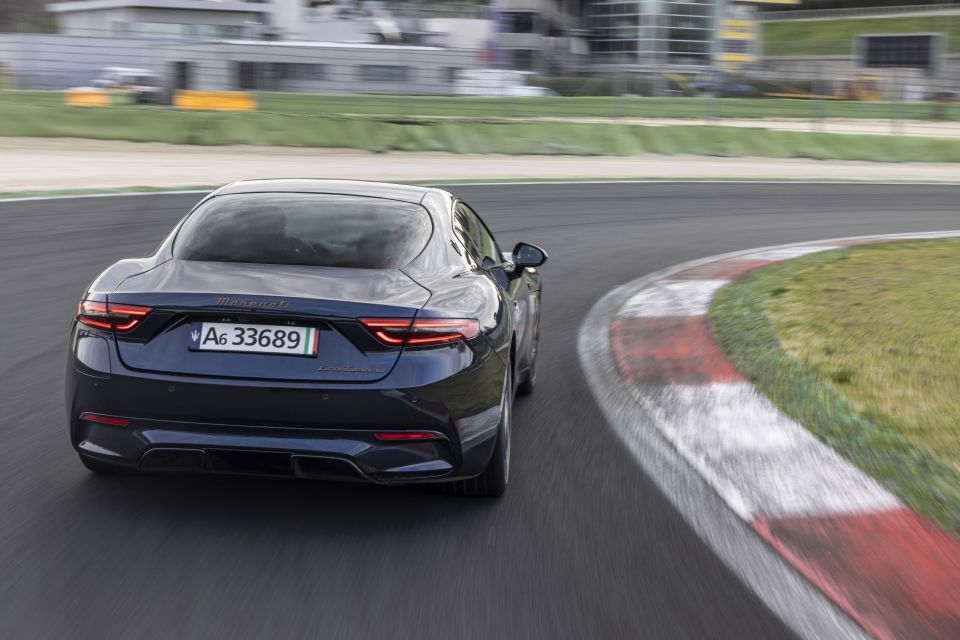
Click the images for the full gallery
Where expert car reviews meet expert car buying – CarExpert gives you trusted advice, personalised service and real savings on your next new car.
Anthony Crawford is a CarExpert co-founder and senior presenter with 20+years in automotive journalism and content creation.


Max Davies
7 Hours Ago


William Stopford
23 Hours Ago


Ben Zachariah
1 Day Ago


Derek Fung
1 Day Ago


Matt Campbell
1 Day Ago


William Stopford
2 Days Ago